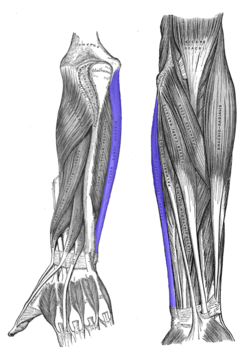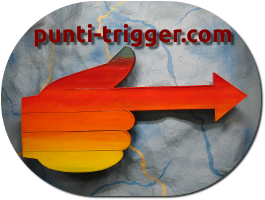So called Golfer's Elbow, or medial epicondylitis, is an inflammation of the tendineous insertion of the inner elbow that involves the flexors of the forearm.
![]()
The term "golfer's elbow" originates from the fact that in golf, the flexors are particularly overused, but the same syndrome can appear e.g. in basketball players, bodybuilders, and even in those massage therapists who don't know trigger point therapy, because tightening the grip in a prolonged manner can overload the flexors (but also the extensors since the two antagonist groups are activated at the same time in order to maintain the hand aligned with the forearm when the fist is clenched).
The main symptom is pain at the medial epicondyle of the elbow, which worsens when tightning the fist, when turning the fist thumb-side outward, when carrying e.g. a heavy shopping bag, when doing biceps curls, and so on.
Therefore in this case the problem is generally caused by the mechanical stress, of either traumatic or chronic nature, at the tendineous insertion, rather than the referred pain caused by trigger points. However, the cause of the perpetuation of mechanical stress, and therefore the absence of healing of possible tendon trauma, is to be found in the taut bands of one or more flexors of the hand. In fact, th exploration of the forearm will reveal one or several extremely tender trigger points that if pressed will cause both referred pain in the specific pain referral area of each flexor, and pain at the Medial Epicondyle. This occurs because the several flexors join together into one and the same tendon that attaches to the Medial Epicondile of the Humerus. Consequently, each flexor can host a trigger point causing stress at the insertion at the inner elbow, while the pain referred distally will be different depending on the involved muscle.
Procedure
From the point of view of trigger point therapy, the manual procedure in the cases of tendinitis consists of identifying the muscles that attach to the inflamed insertion, and then practice two types of massage. The first kind of massage addresses the trigger points of the involved muscles, which trigger points are rarely located near the inflammation, but are instead typically located in the bellies of the muscle bundles, and from there they determine the taut band which is then, in the last analysis, responsible for the mechanical stress at the tendineous insertion. The second type of massage instead does not address the trigger points but the inflammation of the tendon itself, and is appled by massaging the tendon and the muscle-tendon interface orthogonally to the tendon itself, i.e. transversally, the reason being that in ths way the therapist does not risk to aggravate a possible laceration of the tissue (a similar technique of massage done transversally to the direction of the fibers, is used for muscle tears to avoid aggravating the condition).
Therefore, in order to effectively treat golfer's elbow, one needs to locate the main hand flexors, and then the trigger points of each flexor will be treated. In addition, one will need to treat the tendon insertion at the Medial Epicondyle of the Humerus by localized transverse massage. Finally, regular but gentle stretching of the flexors may be added once the trigger points are at least partly deactivated.
So, the first step will be to familiarize oneself with the most important hand flexors.
Flexor Carpi Ulnaris<.strong>

Flexor Carpi Radialis

Palmaris Longus

If we imagine to subdivide the forearm into three segments, the trigger points of the three main muscles are to be found in the segment nearest the elbow.
The Flexor Carpi Radialis trigger point refers pain to the inner wrist just below the thumb.
The Flexor Carpi Ulnaris trigger point instead, refers pain to the inner wrist on the pinkie side, because it attaches to the Pisiform bone. Additionally, in more serious cases it also refers pain to the medial or inner aspect of the elbow. In my experience, the Flexor Carpi Ulnaris can be the main culprit in the golfer's elbow condition. Moreover, the ulnar flexor superiorly also attaches to the Olecranon, and therefore it can entrap the Ulnar Nerve with resulting hand weakness and nerve disorders in the last two fingers.
The Palmaris Longus trigger point causes referred pain in the palm of the hand.
In the forearm, in addition, there are a number of other muscles that cause the fingers to flex and the hand to rotate (pronate), but in my experience these contribute to the golfer's elbow to a lesser extent. Yet, it is good to explore the whole forearm and treat all the trigger points that are identified.
A last remark about stretching: especially when the stretch is applied to small and thin muscles, one must proceed gently and cautiously,because otherwise there is a risk of aggravating the problem and further damaging the tendon attachment. So, the stretching of the hand flexors can be applied by pushing the palm of the hand against a wall with the fingers pointing toward the floor and with the arm extended, but one must proceed with common sense and slowly without exaggerating, while paying attention to maintain a medium to low traction for a longer time, rather than an intense traction for a short time.
